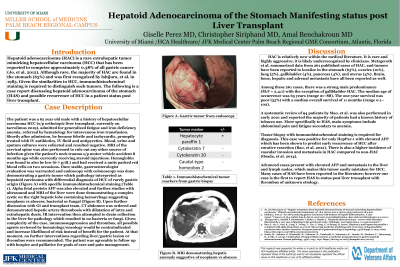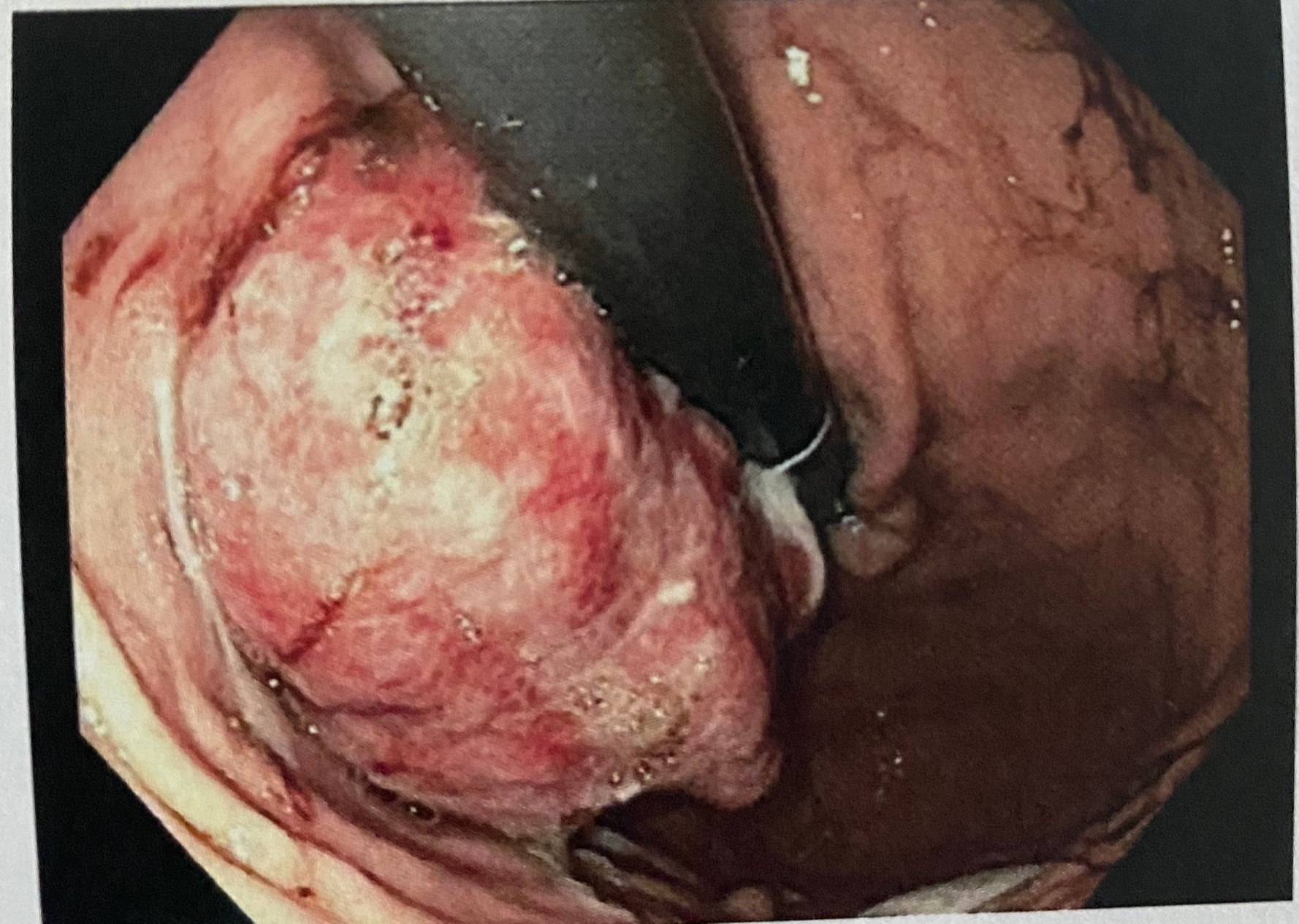Tuesday Poster Session
Category: Stomach
P4239 - Hepatoid Adenocarcinoma of the Stomach Manifesting Status Post Liver Transplant
Tuesday, October 24, 2023
10:30 AM - 4:00 PM PT
Location: Exhibit Hall

Has Audio
- GP
Giselle Perez, MD
University of Miami/HCA Florida JFK Hospital
Deerfield Beach, FL
Presenting Author(s)
Giselle Perez, MD1, Amal Benchakroun, MD2, Christopher Siriphand, MD2
1University of Miami/HCA Florida JFK Hospital, Deerfield Beach, FL; 2University of Miami/HCA Florida JFK Hospital, Lantana, FL
Introduction: Hepatoid adenocarcinoma (HAC) is a rare extrahepatic tumor mimicking hepatocellular carcinoma (HCC) that has been reported to comprise approximately 0.38% of all gastric cancer. Although rare, the majority of HAC are found in the stomach (63%) and was first recognized by Ishijura, et al, in 1985.
Case Description/Methods: A 62 year old male with a history of HCC (s/p orthotopic liver transplant, on tacrolimus), was admitted for generalized fatigue & found to have progressive anemia. His Hemoglobin was noted to be 15.7 g/dL 9 months prior to arrival, when his Hgb was found to be 7.4 g/dL. He was found to have iron deficiency, & thus gastroenterology was consulted for upper & lower endoscopies. A large, bleeding gastric tumor was noted on colonoscopy. Pathology revealed hepatoid carcinoma. Oncology was consulted, & given the rare nature of this particular phenotype, the possibility of primary (or recurrent & metastatic HCC) was also considered. Alpha fetal protein was also elevated. During the hospital course, the patient developed abdominal pain with rising transaminases, prompting further imaging. CT angiography of the abdomen demonstrated hepatic artery thrombosis with dilatation of intra & extrahepatic ducts, along with a lobulated cystic lesion in the liver, suspicious for biloma, infection, or neoplasm. Anticoagulation was contraindicated given the bleeding from the gastric mass. The patient’s transplant team was contacted, & given the unfortunate degree of complexity to this case, all teams including GI, surgery, & oncology deemed the patient hospice appropriate.
Discussion: HAC is relatively new within the medical literature. Metzgeroth et al. summarized data from 261 published cases of HAC, and tumors have been reported to localize in the stomach (63%), ovaries (10%), lung (5%), gallbladder (4%), pancreas (4%), and uterus (4%). Brain, bone, hepatic and adrenal metastasis have all been reported as well. Among these 261 cases, there was a strong male predominance (M:F = 2.4:1) with the exception of gallbladder HAC. The median age of occurrence was 65 years (range 21–88). The one-year survival was poor (55%) with a median overall survival of 11 months (range 0.1–102). More specifically to HAS, main symptoms include abdominal pain and fatigue secondary to anemia. . Many cases of HAS have been reported in the literature; however our case is the first to report HAS in status post liver transplant with thrombus of unknown etiology.

Disclosures:
Giselle Perez, MD1, Amal Benchakroun, MD2, Christopher Siriphand, MD2. P4239 - Hepatoid Adenocarcinoma of the Stomach Manifesting Status Post Liver Transplant, ACG 2023 Annual Scientific Meeting Abstracts. Vancouver, BC, Canada: American College of Gastroenterology.
1University of Miami/HCA Florida JFK Hospital, Deerfield Beach, FL; 2University of Miami/HCA Florida JFK Hospital, Lantana, FL
Introduction: Hepatoid adenocarcinoma (HAC) is a rare extrahepatic tumor mimicking hepatocellular carcinoma (HCC) that has been reported to comprise approximately 0.38% of all gastric cancer. Although rare, the majority of HAC are found in the stomach (63%) and was first recognized by Ishijura, et al, in 1985.
Case Description/Methods: A 62 year old male with a history of HCC (s/p orthotopic liver transplant, on tacrolimus), was admitted for generalized fatigue & found to have progressive anemia. His Hemoglobin was noted to be 15.7 g/dL 9 months prior to arrival, when his Hgb was found to be 7.4 g/dL. He was found to have iron deficiency, & thus gastroenterology was consulted for upper & lower endoscopies. A large, bleeding gastric tumor was noted on colonoscopy. Pathology revealed hepatoid carcinoma. Oncology was consulted, & given the rare nature of this particular phenotype, the possibility of primary (or recurrent & metastatic HCC) was also considered. Alpha fetal protein was also elevated. During the hospital course, the patient developed abdominal pain with rising transaminases, prompting further imaging. CT angiography of the abdomen demonstrated hepatic artery thrombosis with dilatation of intra & extrahepatic ducts, along with a lobulated cystic lesion in the liver, suspicious for biloma, infection, or neoplasm. Anticoagulation was contraindicated given the bleeding from the gastric mass. The patient’s transplant team was contacted, & given the unfortunate degree of complexity to this case, all teams including GI, surgery, & oncology deemed the patient hospice appropriate.
Discussion: HAC is relatively new within the medical literature. Metzgeroth et al. summarized data from 261 published cases of HAC, and tumors have been reported to localize in the stomach (63%), ovaries (10%), lung (5%), gallbladder (4%), pancreas (4%), and uterus (4%). Brain, bone, hepatic and adrenal metastasis have all been reported as well. Among these 261 cases, there was a strong male predominance (M:F = 2.4:1) with the exception of gallbladder HAC. The median age of occurrence was 65 years (range 21–88). The one-year survival was poor (55%) with a median overall survival of 11 months (range 0.1–102). More specifically to HAS, main symptoms include abdominal pain and fatigue secondary to anemia. . Many cases of HAS have been reported in the literature; however our case is the first to report HAS in status post liver transplant with thrombus of unknown etiology.

Figure: Gastric tumor from endoscopy
Disclosures:
Giselle Perez indicated no relevant financial relationships.
Amal Benchakroun indicated no relevant financial relationships.
Christopher Siriphand indicated no relevant financial relationships.
Giselle Perez, MD1, Amal Benchakroun, MD2, Christopher Siriphand, MD2. P4239 - Hepatoid Adenocarcinoma of the Stomach Manifesting Status Post Liver Transplant, ACG 2023 Annual Scientific Meeting Abstracts. Vancouver, BC, Canada: American College of Gastroenterology.
